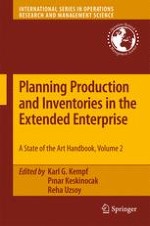In two volumes, Planning Production and Inventories in the Extended Enterprise: A State of the Art Handbook examines production planning across the extended enterprise against a backdrop of important gaps between theory and practice. The early chapters describe the multifaceted nature of production planning problems and reveal many of the core complexities. The middle chapters describe recent research on theoretical techniques to manage these complexities. Accounts of production planning system currently in use in various industries are included in the later chapters. Throughout the two volumes there are suggestions on promising directions for future work focused on closing the gaps. Included in Volume 1 are papers on the Historical Foundations of Manufacturing Planning and Control; Advanced Planning and Scheduling Systems; Sustainable Product Development and Manufacturing; Uncertainty and Production Planning; Demand Forecasting; Production Capacity; Data in Production and Supply Chain Planning; Financial Uncertainty in SC Models; Field Based Research in Production Control; Collaborative SCM; Sequencing and Coordination in Outsourcing and Subcontracting Operations; Inventory Management; Pricing, Variety and Inventory Decisions for Substitutable Items; Perishable and Aging Inventories; Optimization Models of Production Planning Problems; Aggregate Modeling of Manufacturing Systems; Robust Stability Analysis of Decentralized Supply Chains; Simulation in Production Planning; and Simulation-Optimization in Support of Tactical and Strategic Enterprise Decisions. Included in Volume 2 are papers on Workload and Lead-Time Considerations under Uncertainty; Production Planning and Scheduling; Production Planning Effects on Dynamic Behavior of A Simple Supply Chain; Supply and Demand in Assemble-to-Order Supply Chains; Quantitative Risk Assessment in Supply Chains; A Practical Multi-Echelon Inventory Model with Semiconductor Application; Supplier Managed Inventory for Custom Items with Long Lead Times; Decentralized Supply Chain Formation; A Cooperative Game Approach to Procurement Network Formation; Flexible SC Contracts with Options; Build-to-Order Meets Global Sourcing for the Auto Industry; Practical Modeling in Automotive Production; Discrete Event Simulation Models; Diagnosing and Tuning a Statistical Forecasting System; Enterprise-Wide SC Planning in Semiconductor and Package Operations; Production Planning in Plastics; SC Execution Using Predictive Control; Production Scheduling in The Pharmaceutical Industry; Computerized Scheduling for Continuous Casting in Steelmaking; and Multi-Model Production Planning and Scheduling in an Industrial Environment.
